Part 1 of the article provides a summary of rooftop solar (RTS) installations under the PM Surya Ghar Scheme across India, based on data from the Ministry of New and Renewable Energy (MNRE). As of January 2025, RTS installations nationwide reached a total capacity of 16 GW. However, the rate of adoption under the scheme differs across regions varies. In this context, the article discusses the RTS state level solar policies.
Introduction
India is actively steering its energy transition toward decentralized residential RTS across the country. With a national target of 30 GW of rooftop solar capacity by 2027, states play a pivotal role in shaping adoption through their policy frameworks. This article classifies states into four categories such as high support, moderate support, low support and special category, based on the strength and design of their RTS policy support. These classifications are based on the textual analysis of their policies for promoting uptake of rooftop solar. This analysis does not seek to rank installation in the sector but analyse the progressive nature of reforms.
Analysis of RTS policies
I. High Support States
High support states are those where the government makes it especially easy and affordable for people to install rooftop solar panels at home. These states do more than just follow national schemes; they add their own strong financial incentives, often covering 40% or more of the installation cost, so consumers pay much less. The process is made simple and quick, with online portals, less paperwork, and fewer extra fees or technical steps, allowing homeowners to get solar systems up and running without hassle. People can also earn money by selling extra solar power back to the grid at good rates, making solar a smart investment. High support states offer flexible options, such as community solar projects or renting panels, so even those who can’t pay upfront or don’t own their own homes can benefit. Special schemes are often in place for rural families, farmers, low-income groups, or households with low electricity use, and some states even provide free or heavily discounted systems. By removing taxes and extra charges, these states make solar even more accessible. Altogether, high support states combine strong financial help, easy steps, flexible participation, and special support for those who need it most, making rooftop solar practical and appealing for many and helping drive India’s transition to clean energy.
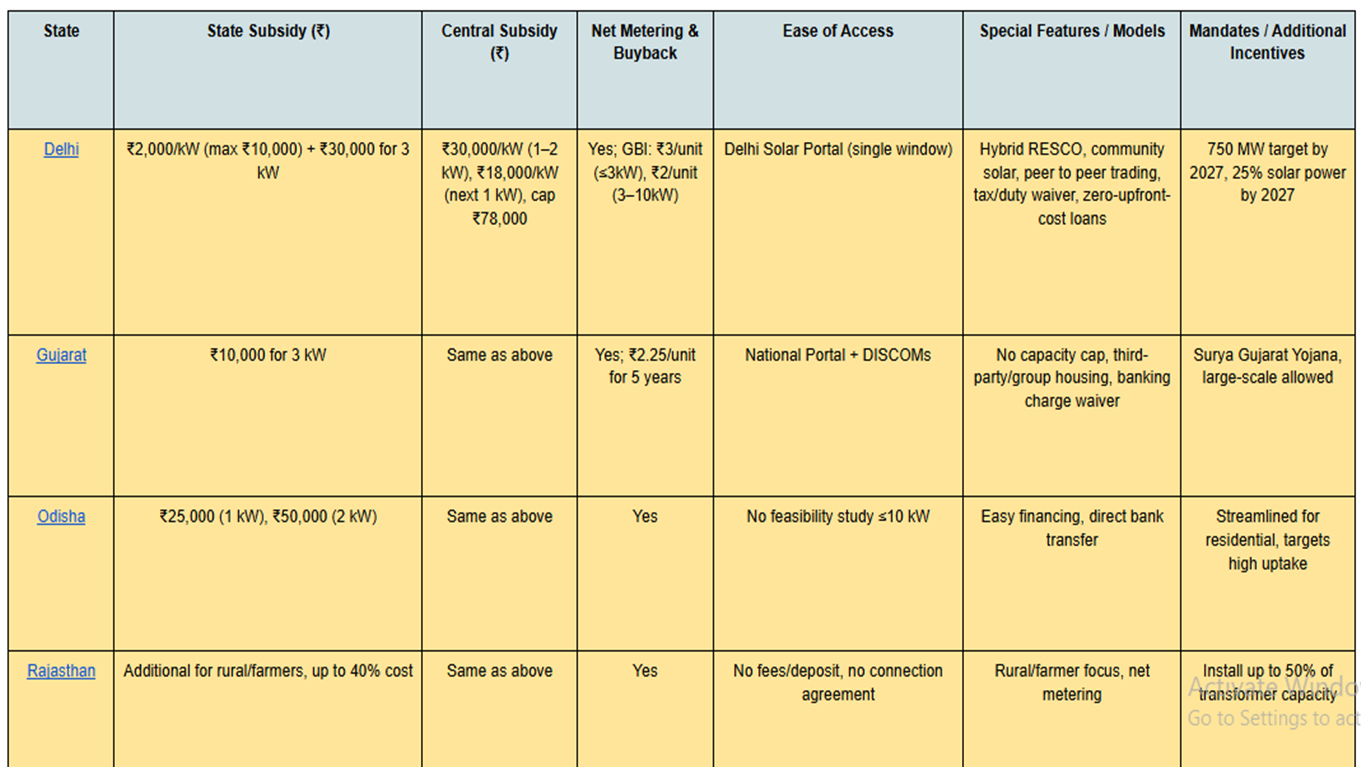
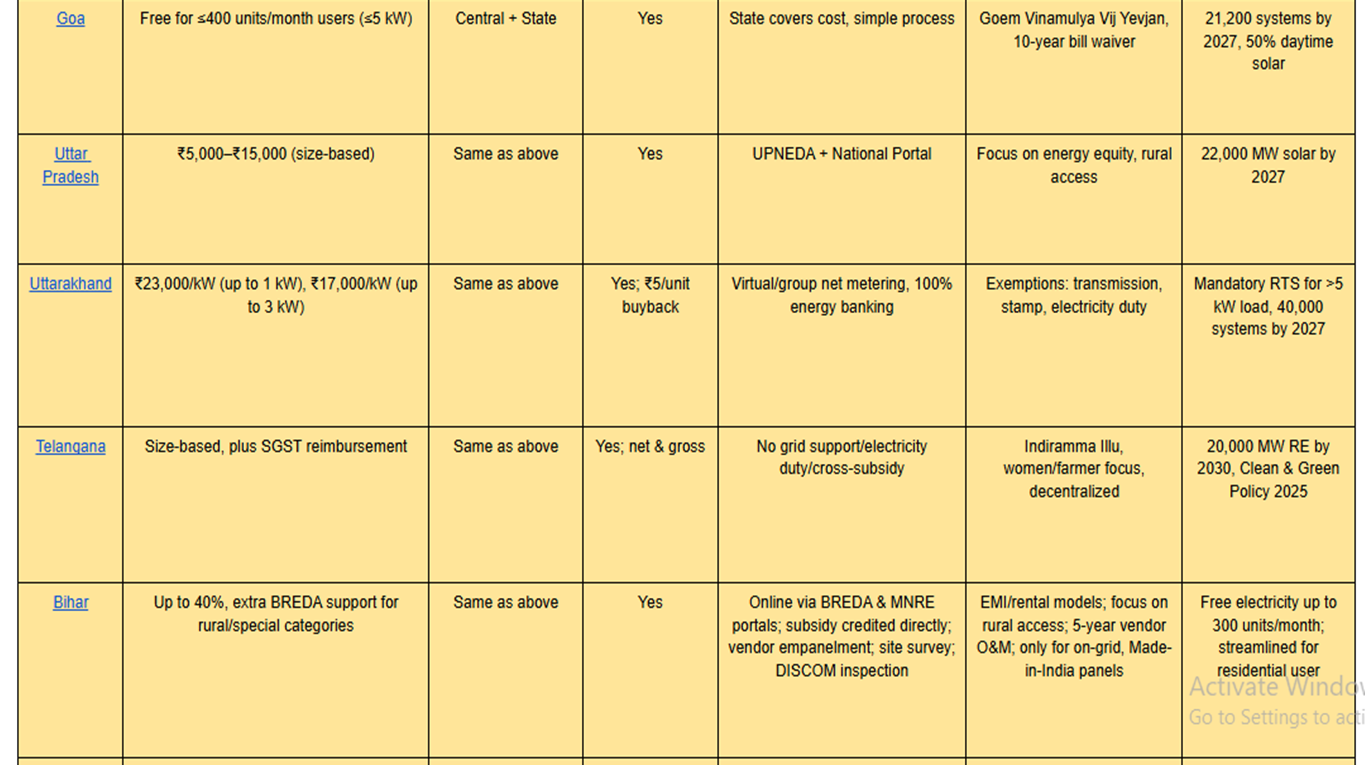

High support states such as Delhi, Gujarat, Odisha, Rajasthan, Uttar Pradesh, Goa, Uttarakhand, Telangana, and Madhya Pradesh stand out because their governments make it much easier and more affordable for people to install RTS panels at their home. Here’s why these states are ahead:
- Savings for Residential Consumers: States like Delhi, Gujarat, and Odisha boost affordability by adding extra subsidies to the central government’s support. These governments often cover 40% or more of the solar panel costs, which significantly lowers installation expenses for families.
- Simplified Application Process: Governments in these states actively streamline the rooftop solar application process by setting up user-friendly online portals and cutting down paperwork. In Delhi, residents access services through the Delhi Solar Portal, while applicants in Gujarat and Uttar Pradesh use the National Portal. Odisha makes it even easier by removing the requirement for a technical study on small systems.
- Earn from Surplus Power: State governments encourage households to sell unused electricity back to the grid by offering competitive rates. Gujarat pays ₹2.25 per unit for five years, while Uttarakhand offers ₹5 per unit, making rooftop solar a more rewarding investment for consumers.
- Flexible and Innovative Options: State governments promote diverse ways to adopt solar energy by supporting group housing projects, panel rental programs, and community solar initiatives. Delhi leads with innovations like peer-to-peer energy trading and hybrid solar models, while Goa enhances access by offering free solar systems to households with low electricity usage.
- Special Help for Certain Groups: Some states give extra help to rural families, farmers, or low-income groups. For example, Rajasthan has extra support for farmers, and Goa gives free solar to households using less than 400 units per month.
- Fewer Extra Charges: Many states remove taxes and extra fees, making it even more affordable for people to go solar.
II. Moderate Support States
Moderate support states promote rooftop solar by combining central government subsidies with targeted local policies. While they may not offer the most state-level incentives, they make solar more accessible through simplified online applications, regulatory reforms like group or virtual net metering, and innovative business models such as pay-per-use and peer-to-peer trading. These states often provide extra support for specific groups, set clear solar adoption targets, and ensure quality through approved vendors and awareness campaigns. Overall, they focus on reducing barriers and expanding participation, helping India progress steadily towards its renewable energy goals.
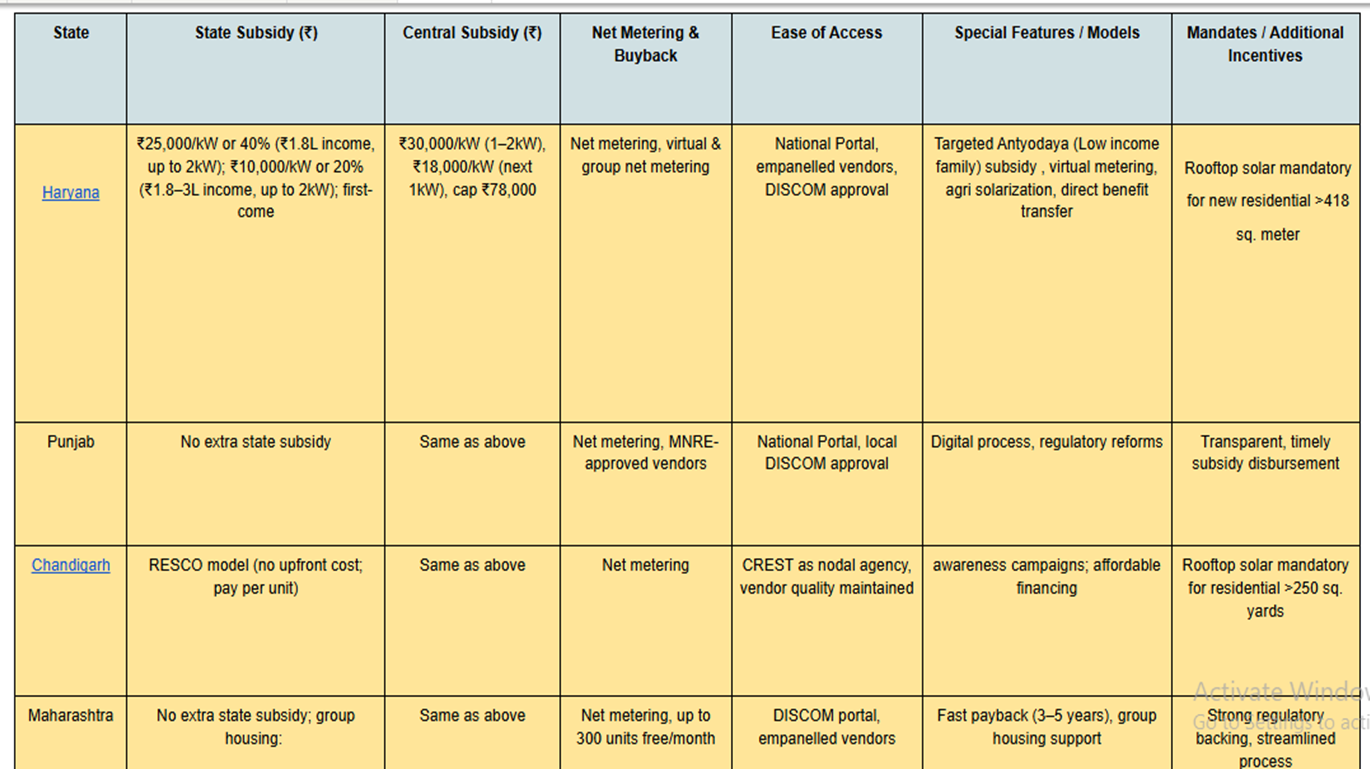
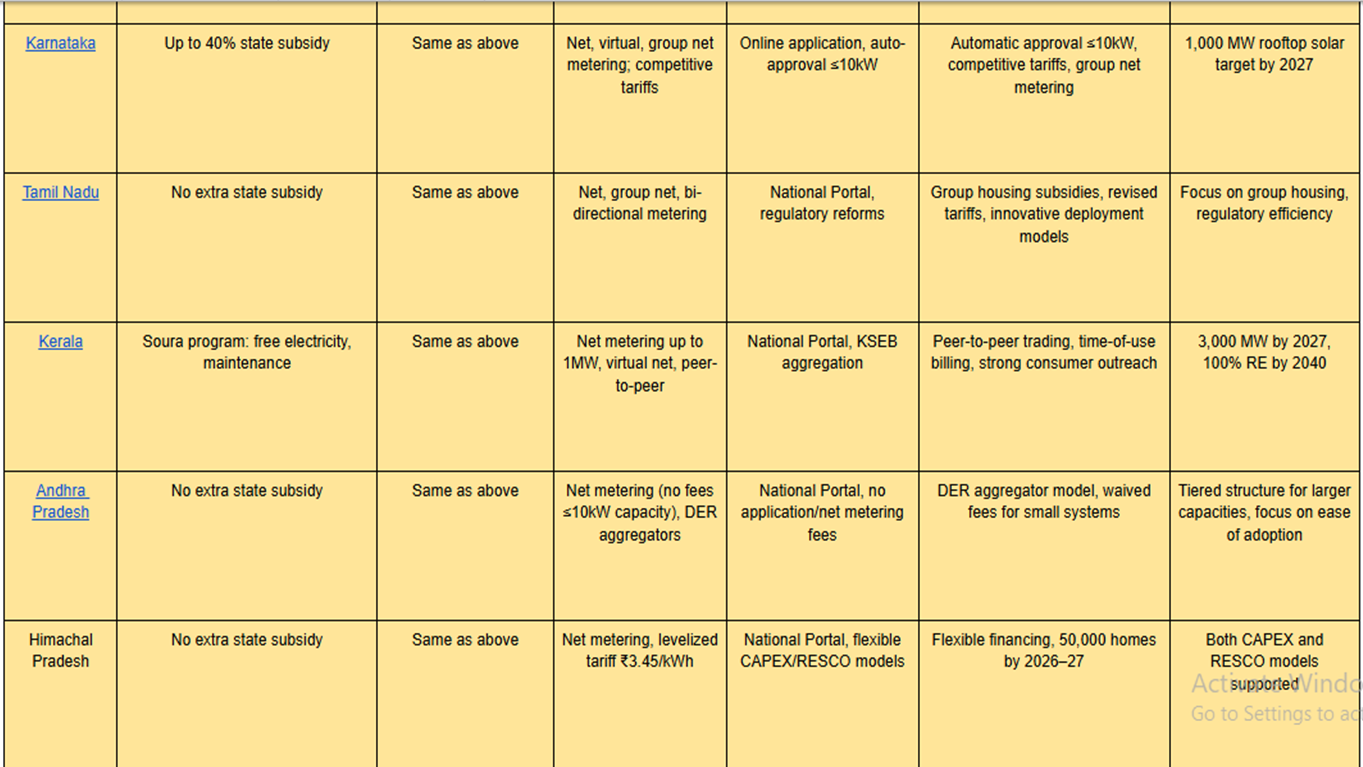
Moderate support states for rooftop solar in India include Haryana, Punjab, Maharashtra, Karnataka, Tamil Nadu, Kerala, Andhra Pradesh, Chandigarh, and Himachal Pradesh. These states use central government subsidies as the main financial support and add their own policies to make solar adoption easier for residents.
- Primary Support: All these states use the central government’s PM Surya Ghar Muft Bijli Yojana, which gives up to ₹78,000 for residential rooftop solar systems. For example, in Maharashtra and Tamil Nadu, most domestic consumers rely on this central subsidy to reduce installation costs.
- Targeted State Support: Some states add extra support for specific groups. Haryana provides an additional ₹25,000 per kW for low-income families, while Karnataka offers up to 40% state subsidy for certain consumers.
- Simple Application and Approval: States like Karnataka and Tamil Nadu allow online applications and automatic approvals for smaller systems, making it easier for people to get started. Chandigarh uses the Renewable Energy Service Company (RESCO) model, so residents can install solar without paying upfront and instead pay for the electricity they use.
- Regulatory Reforms: Many of these states have introduced group net metering and bi-directional metering. For example, Tamil Nadu and Kerala allow apartment complexes or group housing societies to share solar benefits among residents.
- Innovative Business Models: Chandigarh’s RESCO model lets people use solar power without buying the system. Kerala supports peer-to-peer trading and time-of-use billing, so households can sell extra solar power or use electricity when it is cheaper.
- Mandates and Targets: Some states require rooftop solar for new or large homes. For instance, Haryana mandates rooftop solar on new residential buildings above 418 square metres. Karnataka has set a target of 1,000 MW rooftop solar capacity by 2027.
- Consumer Protection and Transparency: These states use approved vendors, run awareness campaigns, and transfer subsidies directly to consumers’ bank accounts. This helps ensure quality and builds trust.
III. Low Support States
Low support states are those where the government relies mainly on central government subsidies to encourage rooftop solar adoption, with little or no additional state-level financial incentives or special schemes. In these states, most of the support for installing solar panels comes from national scheme, and state policies tend to focus on making basic administrative processes easier, such as digitising applications or simplifying approvals. While some may offer targeted support for specific groups or introduce basic regulatory changes like net and gross metering, they generally do not provide broad or generous state subsidies. As a result, residents in low support states benefit primarily from central assistance, and the overall environment for rooftop solar is less proactive compared to states with stronger local policies.
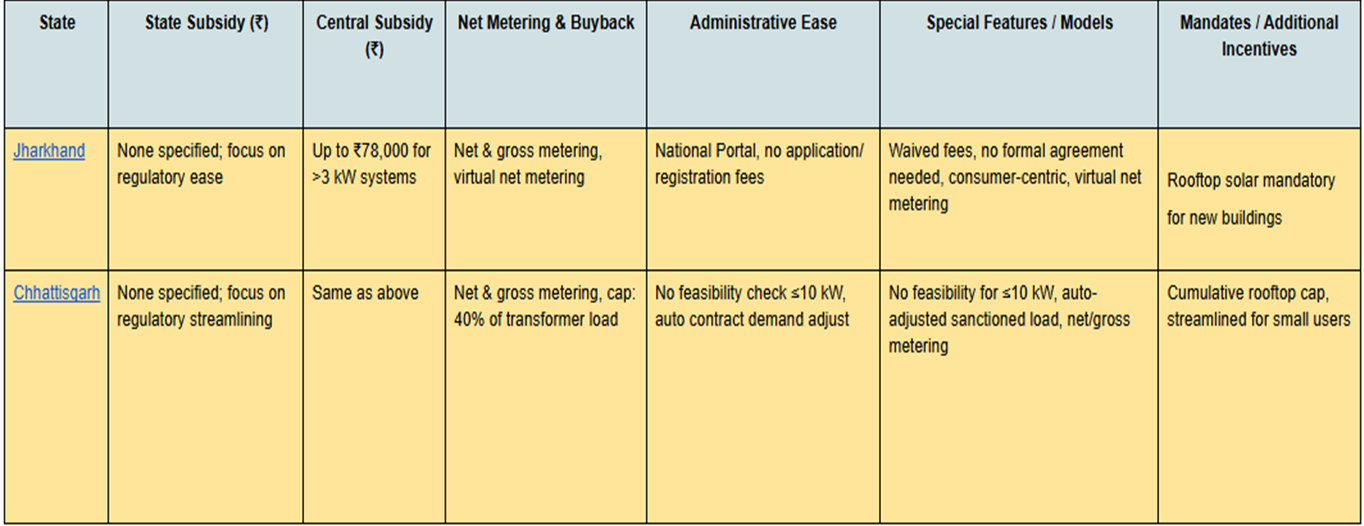
Jharkhand and Chhattisgarh are classified as low support states for rooftop solar adoption. In these states, the primary driver for residential solar installations is the central government subsidy, with state-level policies focused on reducing procedural barriers rather than offering significant financial incentives.
- No Extra State Subsidy: Jharkhand and Chhattisgarh do not give extra state money for installing rooftop solar panels. Most of the financial support comes from the central government’s PM Surya Ghar scheme.
- Net Metering: Both states let you use net and gross metering, so you can lower your electricity bill or sell extra power back to the grid. Jharkhand also allows virtual net metering, which helps people in apartments or shared buildings. In Chhattisgarh, there is a limit: rooftop solar can only use up to 40% of the local transformer’s capacity.
- Easy Application: Jharkhand has removed application and registration fees and does not require a formal agreement with the power company if safety rules are followed. In Chhattisgarh, you do not need a technical check for systems up to 10 kW, and your allowed electricity use is automatically adjusted if your solar system is bigger.
- Special Features: Jharkhand focuses on making things simple for consumers and supports virtual net metering. Chhattisgarh makes it easy for small users and supports both net and gross metering.
- Mandates and Rules: Jharkhand requires new buildings to have rooftop solar. Chhattisgarh limits total rooftop solar capacity in an area to keep the grid stable and makes the process easier for small users.
Special Category
Special category states in India including all North Eastern states and Union Territories follow a centralised rooftop solar policy framework. They align closely with the Ministry of New and Renewable Energy (MNRE) guidelines and benefit from the PM Surya Ghar Scheme, receiving enhanced central financial assistance to promote solar adoption, especially in remote and underserved areas.

- Additional Support : These UTs leverage enhanced central financial assistance, receiving subsidies of up to ₹30,000 per kW for the first 2 kW and ₹18,000 per kW for the next 1 kW, with a total cap of ₹78,000 for systems above 3 kW. Under special category an extra 10% subsidy is provided by the central government.
- Mandate and Rules : The framework mandates the use of the National Portal for Rooftop Solar for all applications, facilitates direct benefit transfers to consumers, and promotes net metering to enable surplus energy exports to the grid. They streamline processes, standardize technical requirements, and prioritize expanding rooftop solar access for households and institutions in remote and underserved regions.
Conclusion
India’s approach to expanding rooftop solar is built on flexible state policies working together with the national PM Surya Ghar scheme. High support states make it easier and affordable for people to install RTS panels by offering extra incentives and simple rules. Moderate and low support states are gradually making their policies better so more people can take part. Special Category States get extra help from the central government to deal with local challenges. By combining these efforts, India is making steady progress towards its goal of 30 GW rooftop solar capacity by 2027. This teamwork between the central and state governments is helping more households use clean, reliable solar energy.
---
Decisions that affect you as a citizen and consumer are shaped by our research. Please support us — every contribution counts.
Add new comment